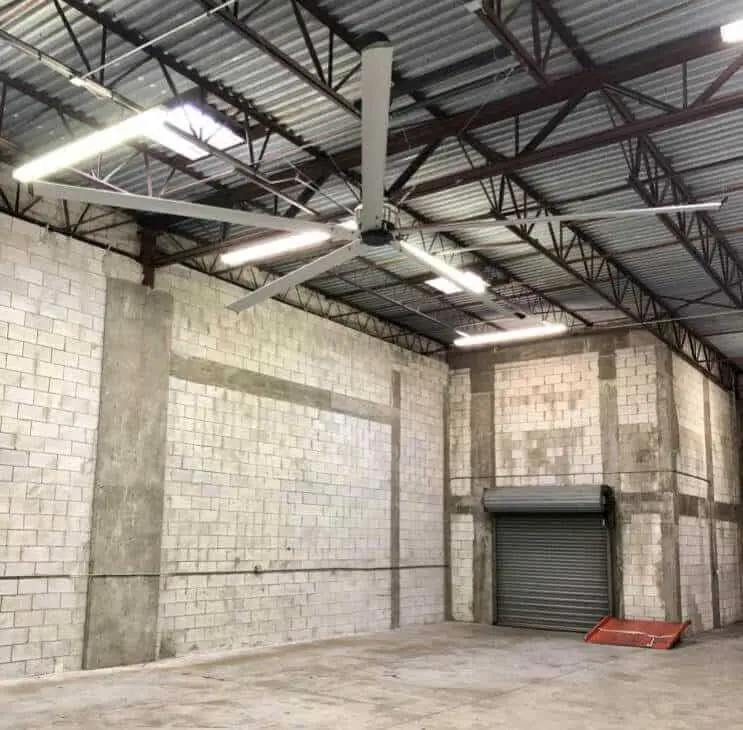
Warehouses are not only expensive, but they also consume a lot of energy. Big rooms, tall ceilings and lots of activity mean it can be difficult to keep the space comfortable without skyrocketing heating costs. That is where high-volume, low-speed fans called HVLS fans enter the picture.
HVLS fans were made for farming and production, but they are now a savvy purchase for those who manage warehouses to control airflow and save energy. But is it really worth spending all that money on them? Let’s find out!
What Are HVLS Fans?
HVLS fans are specially designed for warehouses and run at a slower speed but still move a lot of air. On average, these fans have a diameter of 7 to 24 feet and are put in warehouses to move the air, regulate the temperature and improve the environment for warehouse staff and their goods.
In contrast to standard HVAC systems and narrow high-speed fans, HVLS fans are highly energy efficient and can cool or heat large warehouses.
The Cost of Installing HVLS Fans in Warehouses
We should start with the investment. Several factors influence the installation cost of HVLS industrial ceiling fans, such as the fan’s size, the brand and what’s needed in the facility. Quality HVLS fans supplied by trusted brands can cost anywhere from $3,000 to $7,500 per unit when considering installation. It may look expensive to begin with, but energy savings from HVLS fans usually make up for this over time.
Usually, just a few fans will suffice, but ultimately, the space, ceiling height and layout should be considered when making your plan. Additionally, their durability and the fact that these systems do not require much attention contribute to low TCO (Total Cost of Ownership).
Quantifying the Savings: Energy Efficiency in Action
So, how exactly do HVLS fans reduce energy costs?
In the summer, HVLS fans produce a windy breeze that can make people feel 10 degrees cooler. As a result, HVAC systems can work less or be completely turned off when it is cooler outside.
During the cold seasons, these industrial ceiling fans use their reverse setting to bring warm air from the ceiling to the floor, where everyone can enjoy it. Thanks to this process, heating systems perform better and may save up to 30% on your heating bill.
Real-World Impact:
- Cooling energy savings: 20–50%
- Heating energy savings: 20–30%
- Average payback period: 12–24 months
When compared to traditional HVAC systems, HVLS fans for warehouses deliver significant operational savings, not to mention lower maintenance costs and extended system life due to reduced HVAC strain.
Enhanced Comfort = Higher Productivity
Although reducing energy costs is a main goal, making employees feel better at work is equally valuable. Insufficient airflow and changing room temperatures might reduce how well and how fast people work. Using HVLS industrial ceiling fans as warehouse cooling solutions makes the climate more comfortable everywhere, which reduces employee discontent and ensures they are comfortable as they work.
The ROI of HVLS Fans in Warehouses
When evaluating HVLS fan ROI, it’s essential to look beyond energy bills. Benefits such as reduced equipment strain, fewer climate-related product losses, increased occupant satisfaction, and lower HVAC service costs all contribute to the equation.
ROI Contributors:
- Energy efficiency = Lower monthly utility bills
- Comfort improvements = Higher worker productivity
- Asset protection = Reduced spoilage or damage to goods
- Equipment longevity = Less wear on HVAC systems
- Low maintenance = Minimal upkeep over 10+ years
All these factors combine to deliver a strong return on investment. In most cases, warehouses recoup their initial costs within 1–2 years, with continued savings compounding year over year.
HVLS Fans vs. Traditional HVAC Systems
Keep in mind that HVLS fans are only meant to work alongside your HVAC system. While HVAC systems must use a lot of energy to heat or cool, HVLS fans evenly distribute that air throughout the area.
| Feature | HVLS Fans | Traditional HVAC Systems |
| Energy Consumption | Very Low | High |
| Air Distribution | Large, Consistent Coverage | Often Uneven |
| Installation Cost | Moderate | High |
| Maintenance | Low | High |
| ROI | Fast (12-24 Months) | Slow (5+ Years) |
| Use Case | Air Movement, Comfort, Destratification | Air Heating/Cooling |
High-volume, low-speed fans offer an excellent way to improve the performance of HVAC systems without increasing energy demands, making them a key component of energy-efficient warehouse solutions.
Choosing the Right HVLS Fan Supplier
To maximize ROI and performance, it’s essential to choose a trusted HVLS fan supplier that offers tailored solutions for your facility. Look for a supplier that provides:
- Custom fan sizing and layout planning
- Proven track record in warehouse cooling solutions
- Long-term warranties and after-sales support
- Energy modelling and ROI projections
Conclusion: Are HVLS Fans Worth the Investment?
In short, yes.
The value of HVLS fans in warehouse settings is greater than just their cooling function. They ensure a smooth climate, reduce your utility expenses, make your employees more efficient and add years of reliable operation to your HVAC systems. Thanks to fast returns, simple maintenance and saving a lot on energy, HVLS fans are now essential for making warehouses more energy-efficient.
If your goal is to improve your warehouse’s ventilation, you can partner with a reputable business in the air management industry. Refresh Fans is a leading provider of industrial ceiling fans, ensuring carefully made HVLS fans that fit the needs of warehouses.
Talk to us and find out how the right fan can help your warehouse become more comfortable and energy-efficient